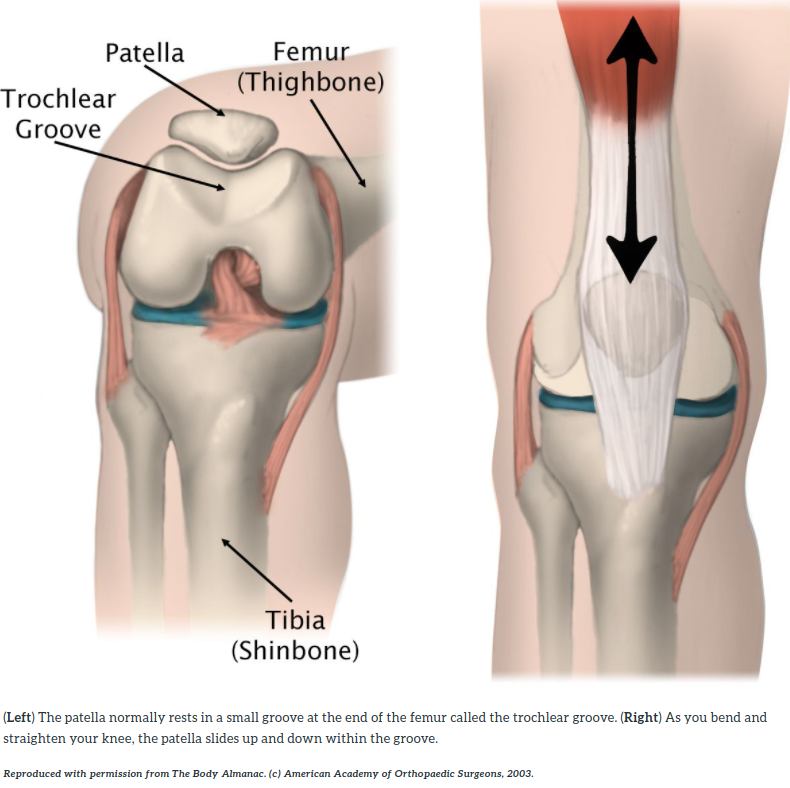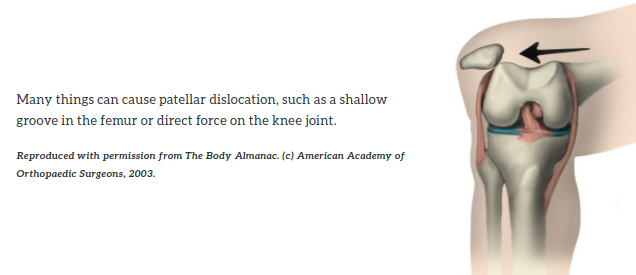Patella Dislocation/Subluxation
Your child's kneecap (patella) is usually right where it should be—resting in a groove at the end of the thighbone (femur). When the knee bends and straightens, the patella moves straight up and down within the groove. Sometimes, the patella slides too far to one side or the other. When this occurs — such as after a hard blow or fall — the patella can completely or partially dislocate.
When the patella slips out of place — whether a partial or complete dislocation — it typically causes pain and loss of function. Even if the patella slips back into place by itself, it will still require treatment to relieve painful symptoms. Be sure to take your child to the doctor for a full examination to identify any damage to the knee joint and surrounding soft tissues.

Cause
There are a several ways in which the kneecap can become unstable or dislocate. In many cases, the patella dislocates with very little force because of an abnormality in the structure of a child's knee.
- A shallow or uneven groove in the femur can make dislocation more likely.
- Some children's ligaments are looser, making their joints extremely flexible and more prone to patellar dislocation. This occurs more often in girls, and the problem may affect both knees.
- Children with cerebral palsy and Down syndrome may have kneecaps that dislocate frequently due to imbalance and muscle weakness.
- Rarely, children are born with unstable kneecaps causing dislocations at a very early age, often without pain.

In children with normal knee structure, patellar dislocations are often the result of a direct blow or a fall onto the knee. This incidence is more common in high-impact sports, such as football.
Dislocations can occur without contact, as well. A common example is that of a right-handed baseball player who dislocates the right patella while swinging the bat. When the right foot is planted on the ground and the torso rotates during the swing, the patella lags behind, resulting in dislocation.
Symptoms
The symptoms associated with a patellar dislocation depend on how far out of place the patella has moved and how much damage occurred when it happened.
Some general symptoms your child may experience include:
- Pain
- Feeling the kneecap shift or slide out of the groove
- Feeling the knee buckle or give way
- Hearing a popping sound when the patella dislocates
- Swelling
- A change in the knee's appearance — the knee may appear misshapen or deformed
- Apprehension or fear when running or changing direction.
Doctor Examination
If your child's patella has slid back into place, you should see your doctor as soon as possible. If your child's patella is still out of place, go to the emergency room.
Medical History and Physical Examination
During the examination, your doctor will ask you and your child about how the injury occurred and specific symptoms. Your doctor also will evaluate the range of motion, tenderness, and appearance of the knee.
Tests
Imaging tests can help your doctor diagnose patellar instability, as well as determine a treatment plan.
- X-rays. These tests create clear pictures of bone. Your doctor may order x-rays to look for skeletal abnormalities in the knee, such as a shallow groove in the femur.
- Magnetic resonance imaging (MRI) scans. These scans create better pictures of the soft structures surrounding the knee, like ligaments. An MRI is seldom necessary because the doctor can usually diagnose a dislocated patella through an examination and x-rays. However, if your doctor needs additional, more detailed images, he or she may order an MRI.
Sometimes a piece of bone or cartilage can dislodge or loosen when the patella dislocates. This can be seen on an x-ray or MRI scan.

Treatment
Immediate Treatment
If your child's patella remains dislocated, go to the emergency room. To put the kneecap back in place, your doctor may give your child pain medication to relax his or her knee muscles, and then gently apply pressure to move the kneecap back into place. This process is called a reduction.
Nonsurgical Treatment
- Immobilization. Your doctor may recommend that your child wear a brace for 3 to 4 weeks. This stabilizes the knee while it heals.
- Weightbearing. Because putting weight on the knee may cause pain and slow the healing process, your doctor may recommend using crutches for the first week or two after the injury.
- Physical therapy. Once the knee has started to heal, your child's doctor will recommend physical therapy to help your child regain normal motion. Specific exercises will strengthen the thigh muscles holding the knee joint in place. Your child's commitment to the exercise program is important for a successful recovery. Typically, children return to activity 3 to 6 weeks after the injury.
Because a dislocation often damages knee tissue, the patella often remains looser, or more unstable, than it was before the injury. As a result, the patella may dislocate again. Recurrences also are common if the dislocation was caused by an irregularity in the knee structure. Ongoing exercises, such as cycling, can strengthen quadriceps muscles in the thigh and prevent future patellar dislocations.
Surgical Treatment
If your child's patella dislocates multiple times, or continues to be unstable despite therapy and bracing, surgery may be recommended to correct the problem. The type of surgery will depend on the cause of the unstable kneecap.
Surgical treatments often involve reconstructing the ligaments that hold the patella in place. This surgery is sometimes performed arthroscopically—using a tiny camera and miniature surgical instruments inserted through small incisions.
Repeated dislocation caused by a congenital or other bone deformity may require more complex surgical treatment.
Safe Return to Play
Once the knee has returned to full motion and strength, your doctor will likely allow your child to resume normal activities. A full return to more demanding sports may take more time. It is also important that the child feels comfortable and ready to resume activity.











